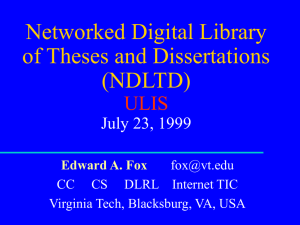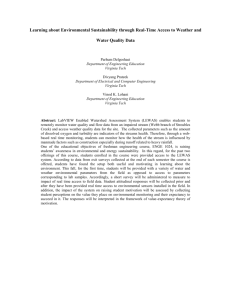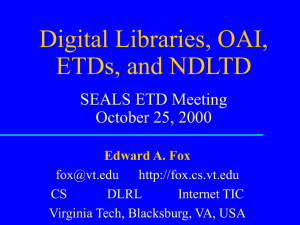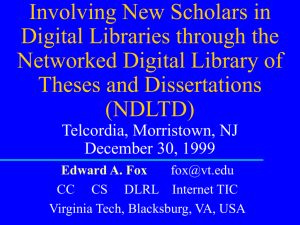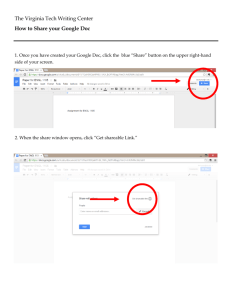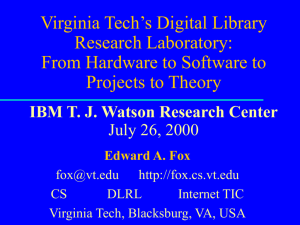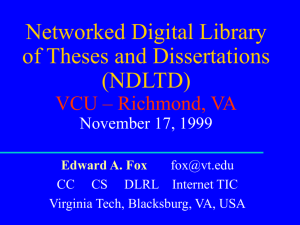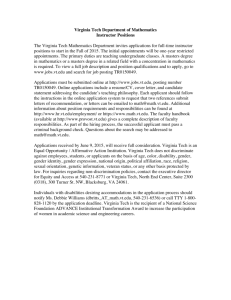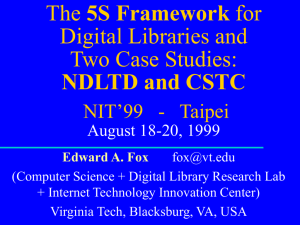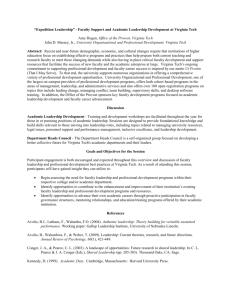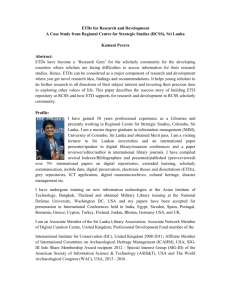View/Open - NDLTD Document Archive
advertisement
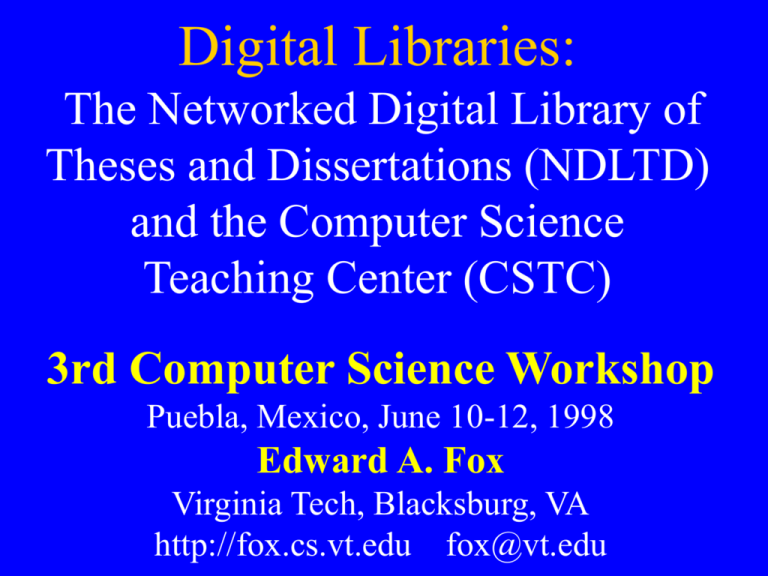
Digital Libraries: The Networked Digital Library of Theses and Dissertations (NDLTD) and the Computer Science Teaching Center (CSTC) 3rd Computer Science Workshop Puebla, Mexico, June 10-12, 1998 Edward A. Fox Virginia Tech, Blacksburg, VA http://fox.cs.vt.edu fox@vt.edu THANKS Hosts for this Workshop NSF – Funding since 1984: AI, Comp. Linguistics, DL, Education, E-pub, HCI, IR, MM, Networking US Dept. of Education (FIPSE) Contributors – Adobe, CNI, CGS, CSGS, IBM, Microsoft, OCLC, SURA, ... – Collaborating universities (you too, soon, I hope!) ACKNOWLEDGEMENTS / CONTEXT NDLTD PIs: Ed Fox - Computer Science (fox@vt.edu) John Eaton - Graduate School (eaton@vt.edu) Gail McMillan - Library (gailmac@vt.edu) CSTC PIs: Deborah Knox - The College of NJ Scott Grissom - U. Illinois Springfield (Rachelle Heller - GWU - CRIM) Infrastructure: Net.Work.Virginia (vBNS, Internet 2, LMDS, Blacksburg Electronic Village, FDI) A Complete Approach to Advanced Network Access Mid-Atlantic Crossroads (MAX) NET.WORK.VIRGINIA Regional/National Leadership Statewide Access LMDS / Local NAPS Virginia Tech Last Mile ESnet Net.Work.Virginia Architecture Backbone / Internet Gateway vBNS Internet2 Internet SprintLink Router DS3 OC3 Sprint WTN OC3 OC3 Sprint RIC OC3 Sprint ROA jmc 1/3/97 NET.WORK.VIRGINIA 222 Sites by Type and Bandwidth May, 1998 Higher Education K-12 Education State Government Localities / Libraries DS-1 (1.544 Mbps) DS-3 ( 45 Mbps) OC-3 (155 Mbps) Frame Relay - ATM (FRANI) Faculty Development Initiative Music Art & Art History English Religious History Studies Philosophy Women's Studies Black Studies Newman Library Information Systems Educational Technologies Chemistry Physics Biochemistry Biology Mathematics Computer Science Cyberschool I and II Communications Political Science Psychology Sociology Human Resources University Honors Education Center for Excellence in Undergraduate Teaching URLs Cyberschool http://www.cyber.vt.edu Cyberschool White Papers http://www.cyber.vt.edu/wp ACCESS Project http://www.edtech.vt.edu/access aTECH Project http://juno.atech.vt.edu LIT Project http://athena.english.vt.edu/LIT/LIT.html Digital Libraries Why of global interest? Why of interest in computing? Definitions NSF Digital Libraries Initiative DLs: Why of Global Interest? National projects can preserve antiquities and heritage: cultural, historical, linguistic, scholarly Knowledge and information are essential to economic and technological growth, education DL - a domain for international collaboration – – – – wherein all can contribute and benefit which leverages investment in networking which provides useful content on Internet & WWW which will tie nations and peoples together more strongly and through deeper understanding Why of Interest in Computing? Next step in fields of DBMS, HT, IR, MM Efficiency requires advances in, e.g., – algorithms and data structures (ex., MPHF) – networking (ex., HTTP-NG) – OS (ex., support for streams) Effectiveness requires advances in, e.g., – AI (ex., multilingual texts, user adaptation) – HCI (ex., visualization, DLs embedded in activities) CS Educ. can benefit; CS can aid Dist. Educ. DLs: Definitions Super information systems KDI with persistence, organization, usability Libraries extended to include collections of digital objects and to provide expanded services to distributed user communities without prior limitations of space, time, physical instantiation Latest implementation of visions of Bush, Licklider, Nelson, and previous scholars Systems, services, institutions, enterprises, and projects of the digital library community National Synchronization Home Page http://dli.grainger.uiuc.edu/national.htm DIGITAL LIBRARIES INITIATIVE Funded through a joint initiative of: National Science Foundation Defense Advanced Research Projects Agency National Aeronautics and Space Administration Stephen M. Griffin Division of Information and Intelligent Systems National Science Foundation sgriffin@nsf.gov Communications (bandwidth, connectivity) Locating Digital Libraries in Computing and Communications Technology Space Digital Libraries technology trajectory: intellectual access to globally distributed information Computing (flops) Digital content less more Digital Libraries Initiative - Phase 2 Core Sponsors: NSF, DARPA, NLM, LoC, NASA, NEH ~$8-10 million/yr for 4-5 years (beginning FY98) sponsor a full-spectrum of activities – fundamental research, content & collections development, domain applications, testbeds, operational environments, new resources for education and preserving America’s cultural heritage address topics over entire DL lifecycle – information creation, dissemination, access, use, preservation, impact, contexts implement a modular, open program structure – add new sponsors, performers, projects at any time Program Goals: new DL research, technologies and applications to advance the use of distributed, networked information of all types around the nation and the world Digital Libraries Initiative - Phase 2 Planning Underway to Secure Funding and Launch Full-Scale Program of Support for International Collaborative Activities in Digital Libraries Beginning in FY 1999 Goals for the Future Gather information and build collections (to understand the incompleteness of our knowledge) • Create new communities (to communicate and collaborate) • Make technology disappear (from our awareness and experience) NDLTD News, Background/History Vision, Benefits, Approach, Possibilities Concerns, Problems, Opposition Solutions, Implementation, Results, Plans NEWS, BACKGROUND/ HISTORY ETDs Got Your Interest? ETD Web Site http://www.ndltd.org/ Graduate Students U. Laval Media Chronicle NPR NY Times ... What led to today’s situation? 1987 mtg in Ann Arbor: UMI, VT, … 1992 mtg in Washington: CNI, CGS, UMI, VT and 10 universities with 3 reps each 1993 mtg in Atlanta to start Monticello Electronic Library (MEL): SURA, SOLINET 1994 mtg in Blacksburg re ETD project: std of PDF + SGML + multimedia objects 1996 funding by SURA and US Dept. of Education (FIPSE) for regional, national projects (NDLTD) University Scholarly Electronic Pub. (1988) Library Cancellations (1988) Graduate Education ETD Initiative WWW (1994) Internet (1984) PDF (1992) SGML (1985) Info. Literacy (1995) DL (1994) Multimedia (1986) What are we doing? Aiding universities to enhance grad educ., publishing and IPR efforts: to help improve the availability and content of theses and dissertations Educating ALL future scholars so they can publish electronically and effectively use digital libraries (i.e., are Information Literate and can be more expressive) Demonstrating how, for other organizations VISION, BENEFITS, APPROACH, POSSIBILITIES A Digital Library Case Study Electronic theses and dissertations (ETDs) Submission: http://etd.vt.edu Collection: http://www.theses.org Networked Digital Library of Theses and Dissertations (NDLTD) http://www.ndltd.org (formerly “National” because of Fed. funds, before international members started joining) Something for Everyone Students - contribute -> gain acclaim Universities - join -> help your students, gain increased DL experience + visibility Researchers - use, encourage -> content Publishers - liaise, support -> have more knowledgeable authors + backup details DL enthusiasts - adapt resources / ideas -> have exemplary pilot / model project What are the key ideas? People can switch to electronic documents – Becoming more expressive with hypermedia Mandating ETDs will change all future scholarship Scalability – Empower authors to submit to DL, as a natural part of the educational process – Study workflow & apply automation, so institutions streamline processing and build their part of the DL – Federate along most suitable cultural/political lines Key Ideas: Scalability Networked infrastructure University collaboration Workflow, automation Maximal access Education is the rationale 8th graders vs. grads Authors must submit Standards PDF, SGML, MM MARC, DC, URNs Federated search What are the benefits? Save students money Save handling, shelf space in libraries Build the Networked Digital Library of Theses and Dissertations: with faster, broader, and less expensive access Demonstrate how universities can work together directly (vs. indirectly through publishers or associations) What are the long term goals? 400K US students / year getting grad degrees are exposed / involved 200K/yr rich hypermedia ETDs that may turn into electronic portfolios Dramatic increase in knowledge sharing: lit. reviews, bibliographies, … Services providing lifelong access for students/researchers: browse, search, prior searches, citation links, ... Grad Student Assistant? Record all work with NDLTD, return to prior situation, prepare bibliography Powerful (multilingual, text, image) searching, browsing (with categories), following citation links Support collaboration with others in same field: help with literature review, sharing tools and data sets, applying their methods Undergraduate honors thesis: Todd Miller Social Capital? Increase local interchange among students, faculty, library, graduate school Increase international understanding, building many more invisible colleges, with students more empowered Connect graduate researchers with undergrads, who can access ETDs / them Facilitate direct university collaboration, explicitly, in reshaping publishing world How are ETDs being done at Virginia Tech? Some produced w. SGML (XML) Most produced using standard word processing packages as PDF files – – LaTeX class, outline fonts, Distiller Word template, export to PDF (XML) Reviewed by the Graduate School Cataloged and archived by the library Ds downloaded by UMI from server Student Prepares Thesis or Dissertation NDLTD Literature Computer Resources Research Student Defends and Finalizes ETD My Thesis ETD Student Gets Committee Signatures and Submits ETD Signed Grad School Graduate School Approves ETD Student is Graduated Ph.D. Library Catalogs ETD and New Students Have Access to the New Research WWW NDLTD Status of the Local Project Approved by university governance Spring 1996; required starting 1/1/97 Submission & access software in place Submission workshops for students (and faculty) occur often: beginner/adv. Faculty training as part of Faculty Development Initiative Over 1000 ETDs in collection Statistics 30-40K accesses/week to WWW site 300K accesses of ETD HTML pages – 80K downloads of PDF version of ETDs – 5 most popular ETDs: 10K, 8K, 2800, 2500, ... Multimedia content: about 65% have some – 45% have images, 5% have movies – 1 w. 85 VRML files, 1 w. 378M Director file See details: http://scholar.lib.vt.edu/theses/ OCLC has about 3.5M TD MARC records UMI Dissertation Abstracts has 1.5M entries Initial Stats 1996 Total successful requests: Average successful requests per day: Requests for .PDF files ( full ETDs): Requests for .HTML file Distinct hosts served Total data transferred: Average data transferred per day: 37,171 102 4,600 28,225 9,015 3,229M 9,038K 1997 247,573 685 72, 854 129,831 22,725 25,953M 73,574K Popular Works 1996 458 Seevers, Gary L. Identification of Criteria for Delivery of Theological Education Through Distance Education: An International Delphi Study (Ph.D., Educational Research and Evaluation, April 1993; 1353Kb) 432 Hohauser, Robyn Lisa. The Social Construction of Technology: The Case of LSD (MS in Science and Technology Studies, Feb. 1995; 244Kb) 390 Childress, Vincent William. The Effects of Technology Education, Science, and Mathematics Integration Upon Eighth Grader's Technological Problem-Solving Ability (Ph.D. in Vocational and Technical Education, July 1994; 285Kb) 310 Kuhn, William B. Design of Integrated, Low Power, Radio Receivers in BiCMOS Technologies (Ph.D. in Electrical Engineering, Dec. 1995; 2Mb) 287 Sprague, Milo D. A High Performance DSP Based System Architecture for Motor Drive Control ( MS in Electrical Engineering, May 1993; 878Kb) 165 Wallace, Richard A. Regional Differences in the Treatment of Karl Marx by the Founders of American Academic Sociology (MS in Sociology, Nov. 1993; 479Kb) 150 McKeel, Scott Andrew. Numerical Simulation of the Transition Region in Hypersonic Flow (Ph.D. in Aerospace Engineering, Feb. 1996; 3Mb) Popular Works 1997 9920 Liu, Xiangdong. Analysis and Reduction of Moire Patterns inScanned Halftone Pictures (Ph.D. in Computer Science, May 1996; 6.6Mb) 7656 Petrus, Paul. Novel Adaptive Array Algorithms and Their Impact on Cellular System Capacity (Ph.D. in Electrical Engineering, March 1997; 5Mb) 2781 Agnes, Gregory Stephen. Performance of Nonlinear Mechanical, Resonant-Shunted Piezoelectric, and Electronic Vibration Absorbers for Multi-Degree-of-Freedom Structures (Ph.D. in Engineering Mechanics, Sept. 1997; ? + 7926Kb) 2492 Gonzalez, Reinaldo J. Raman, Infrared, X-ray, and EELS Studies of Nanophase Titania (Ph.D. in Physics, July 1996; 4607Kb) 1877 Shih, Po-Jen. On-Line Consolidation of Thermoplastic Composites (Ph.D. in Engineering Mechanics, Feb. 1997; 3.3Mb) 1791 Saldanha, Kevin J. Performance Evaluation of DECT in Different Radio Environments (MS in Electrical Engineering, Aug. 1996; 3.2Mb) 1431 DeVaux, David. A Tutorial on Authorware (MS in CS, April 1996; 2.3Mb) 1394 Kuhn, William B. Design of Integrated, Low Power, Radio Receivers in BiCMOS Technologies (Ph.D. in Electrical Engineering, Dec. 1995; 2518Kb) International Use 1996 850 608 346 713 387 463 183 22 83 1997 2,922 United Kingdom 2,501 Australia 2,378 Germany 2,367 Canada 1,264 South Korea 1,161 France 1,130 Brazil 967 Thailand 958 Greece Universities Visiting / Visited by Virginia Tech Staff Auburn CMU Columbia Drexel U. Florida Int’l Univ. Georgia Tech Hong Kong James Madison U. MIT (Nat’l Lib. Canada) Nat’l Univ. Singapore New York U. Ohio State U. Penn State Rice Univ. Rutgers Univ. San Jose State U. Stanford Univ. Tech. Univ. Portugal U. Alabama U. Alabama Birmingham U. Arizona U. CA Berkeley U. CA Santa Barbara U. Central Florida U. Delaware U. Denver (+CSU,CU Boulder) UDLA (Puebla, Mexico) U. Florida U. Ill. Urbana Champaign U. Massachusetts Amherst U. Michigan U. NC Charlotte U. North Florida U. Pennsylvania U. Utah U. Waterloo Virginia Commonwealth U. William & Mary Universities Officially Part of NDLTD U. Laval (Canada) University U. Maine Concordia University (IL) U. of New South Wales (AU) Darmstadt U. of Tech. (GE) U. of South Florida Florida Institute of Tech. U. of Tennessee, Knoxville Michigan Tech U. of Tennessee, Memphis Naval Postgraduate School U. of Virginia North Carolina State U. U. Waterloo (Canada) Rhodes U. (South Africa) U. Wisconsin - Madison Rochester Institute of Tech. Vanderbilt U. University of Florida Virginia Tech University of Georgia West Virginia U. University of Guelph (Can.) Wilfrid Laurier U. (Can.) U. of Hawaii, Manoa Plus: 1 in S. Korea, HQ of CIC, ... Clemson User Search Support NDLTD World Federated Search User Interface Virginia Tech ... (univ) UMI ... (corporate) CIC ... (univ group) Portugese NL ... (national lib) NATO ... (regional) Note: Above are illustrative, in some cases potential. Interoperability Tests Planned Locally developed federated search IBM DL: donated equipment Z39.50: OCLC SiteSearch / VT tailored s/w – university libraries w. catalogs of freely shared MARC records pointing to archival copies – via URNs: handles & PURLs Dienst / NCSTRL - www.ncstrl.org: CS depts., DARPA, NSF, CNRI, Cornell - UVA is working on extensions for ETDs - Portugal is studying use for Europe - VT is working on Dienst to Z39.50 gateway Access Approaches Goal: Maximize access and services, e.g., by encouraging: UMI centralized services Distributed service: Dienst, Z39.50 Regional services (e.g., CIC, MEL) Local servers with browse, search From local catalogs to local archives WWW robot indexing and search services – Why might your university want to be involved? To improve graduate education / better prepare your students To unlock university information To save money for students and for the university / improve workflow To build an important digital library supported by SURA, FIPSE How can your university get involved? (www.ndltd.org/join) Select – – – – planning/implementation team Graduate School Library Computing / Information Technology Institutional Research / Educ. Tech. Send us letter, give us contact names Adapt Virginia Tech solution – – Build interest and consensus Start trial / allow optional submission Contact Our Project Team Video Tape E-mail etd@ndltd.org Phone Call Visit Convene Local Planning Group ETD Join NDLTD: Get a CD-ROM WE JOIN Signed Letter ETD CD-ROM Build Your ETD Site ETD Workshop/Training Digital Library Policies Inspection/Approval Type 1 Members University Requires ETDs Adobe Acrobat and/or SGML tools Automated submission & processing Archive/access through UMI, (OCLC,) Virginia Tech, ... (Local) WWW site, publicity (Local) Assistance provided as requested: email, phone, listserv(s) Type 2 Members University Agrees to Require ETDs Like Type 1 but set date not reached Usually has an option or pilot May: wait for new AY; start with all who enter after; … Build grass roots support – – – – Advisory committee: representative? expert? Champions to spread by word of mouth Approval: Senates, Commissions, Deans, Students Publicity to reach community Types 3-7 3. Part of university requires ETDs 4. University allows ETDs 5. University investigating, has pilot 6. University consortium joins 7. Non-university organization joins CONCERNS, PROBLEMS, OPPOSITION How does this relate to UMI? 1987 UMI workshop to explore ETDs Support letter for US Dept. of Ed. proposal Steering & technical comm. membership Difference in focus: on education, theses ProQuest Direct pilot of scanning works started 1/1/97 Collaborating on: – – accepting electronic author submissions standards (e.g., representation), research ETD Initiative (and UMI) Students Learn about DL, EPub TDs become more expressive Universities UMI N. Amer. (T)Ds are accessible, archived Global TDs become more accessible, archived Some Barriers at Universities Lethargy; Not invented here (esp. large univ’s) Anger with unfunded, added, required work Last straw: using more frustrating technology Lack of experience in working together: graduate school, library, computing staff Lack of interest in (quality of) student work More loyalty to discipline than campus Unwillingness to accept responsibility for growing financial problems with libraries SOLUTIONS, IMPLEMENTATION Level 0 Involvement RISK FREE - allow students Adobe Acrobat in bookstore Submission allowed (e.g., J. Daniels) Archive/access through UMI, Virginia Tech, ... (Local) WWW site, publicity (Local) Assistance provided as requested: email, phone, listserv(s) Level 1 Involvement = Level 0 + LOW COST - help & encourage students Install our software, change practices in graduate school and library Train students Build grass roots support – – – – Advisory committee: representative? expert? Champions to spread by word of mouth Approval: Senates, Commissions, Deans, Students Publicity to reach community Level 2 Involvement = Level 1 + EVENTUAL FULL INVOLVEMENT Require electronic submission Have firm arrangement with local library, OCLC, VT and/or UMI re archival services Share MARC records, with URNs pointing to archive copy (Stock laboratories) (Run servers: search, URN) (Launch evaluation program) Support Services Developed CD/WWW site with > 300M: student guidelines, listservs, FAQs, press info, multimedia training materials Automated submission system SGML DTD for ETDs, SGML to HTML (web generator) Donations: Adobe, Microsoft Evaluation: instruments, analysis Relationship with publishers Concern of faculty and students that still wish to publish books or journal articles, voiced: campus, Chronicle, NPR, Times Solution: Approval Form gives students, faculty choices on access, when to change access condition; use IPR controls in DL Solution: by case, work with publishers and publisher associations to increase access – – AAP, AAUP AAAS, ACM, ACS, Elsevier, ... Some responses from publishers ACM: need to acknowledge copyright Elsevier: need to acknowledge copyright IEEE-CS: endorse initiative AAAS: Science wants first publication Textbook publishers: different market, manuscript significantly reworked General: restricting access to local campus will not cause any problems Plans Nurture federation -> summer workshop (now, in Memphis) Increase # members -> lower barriers by supporting pilot efforts directly R&D in federated fashion – – – – USF: writing UVA / U.Mich.: SGML Portugal: national library requirements Singapore: multilingual support with UNICODE Summary Sustainable, Scalable: started in 1987, growing, coupled with education Open: everyone welcome, mutually agreed-upon standards, building international collaborative community Content: valuable, high demand, aiming toward completeness Usability: applying latest and future DL research so can easily submit, utilize NDLTD Future Work Working with publishers to increase level of access as much as possible Interoperability tests among universities and with UMI to provide integrated services Study with testbed that emerges, to improve information retrieval, browsing, interface, and other types of user support Evaluation, improving learning experience, spread to worldwide initiative, sustainable support and coordination CSTC NCSTRL, VT Grants Vision, Benefits, Approach Concerns, Problems Solutions, Plans NCSTRL: CS TECHNICAL REPORTS CS TR project supported by ARPA (Berkeley, CMU, Cornell, MIT, Stanford) WATERS project for other departments led by ODU, SUNY Buffalo, UVA, VPI&SU summer 1995 to www.NCSTRL.org (Networked CS Tech Report Library) Most large departments now have joined “Central” server: UVA, “backup”: VPI&SU 1998 extension to preprint service, with LANL Merger Virginia Tech GRANTS 1991-1993 ENVISION project funded by NSF 1993-1998 “Interactive Learning with a Digital Library in CS” by NSF: http://ei.cs.vt.edu (10M accesses to over 45 courses) 1998-2000 “Computer Science Teaching Center” by NSF and ACM Education Board: http://ei.cs.vt.edu/~cstc/ “Curriculum Resources in Interactive Multimedia” by NSF : 1998-2000 http://ei.cs.vt.edu/~crim/ ENVISION A User-Centered Database from the Computer Science Literature (1991-93) Collected bib. data, converted to SGML Converted typesetter data to SGML Scanned thousands of page images MARIAN search engine (also applied to the Virginia Tech library catalog) used as part of a prototype object-based DL, with tailored visualization interface (L. Nowell dissertation) NSF Education Innovation (EI) NSF “Interactive Learning with a Digital Library in Computer Science” (1993-98) 45 online courses, 100+K accesses/wk, plus: DL courseware, overall EI project pages Tools: SWAN (visualization), QUIZIT Evaluation – traditional – network logging and analysis – tools for visualization QUIZIT (Lucio Tinoco) SGML generates HTML & answer files MSQL supports records database Automated password request supported Password allows review of taken quizes Password allows selection of next quiz 4 types of questions are supported Feedback provided if questions are missed PAPERLESS COURSES CS1604: Introduction to the Internet CS3604: Professionalism in Computing CS4624: Multimedia, Hypertext and Information Access (MHIA) CS5604: Information Storage and Retrieval CS6604: Digital Libraries EVALUATION: Log Analysis WWW traffic logging, analysis, modeling, simulation, prediction (G. Abdulla) Students with same grades learn by knowing or by knowing how to search Regression predicts course’s traffic Modeling of hourly, daily, seasonal trends Understand users, plan future networks MHIA Workshops ACM: SIGIR’96, MM’96, SIGIR’97-DL’97; IEEE CS: ICMCS’97, … (MM’98, Sept. in UK) Aim: Curriculum Guidelines for MHIA Area New Programs, ex. Euro EI Masters Reusable WWW Knowledge Modules New Courses, ex. Hypertext, IR, Multimedia Add-ons to Existing Courses (Comparative Languages, DBMS, HCI, Networking, OS) Vision, Benefits, Approach Instead of building large, expensive multimedia packages, that become obsolete and are difficult to re-use, concentrate on small knowledge units. Learners benefit from having well-crafted modules that have been reviewed and tested. Use digital libraries to build a powerful base of support for learners, upon which a variety of courses, self-study tutorials & reference resources can be built. (See NSF SMETE-Lib Study at http://www.dlib.org/smete/public/smete-public.html) Concerns, Problems Motivating educators to create modules that can be used elsewhere is difficult without a suitable reward structure and an infrastructure of testing, packaging, discovery, reuse, and evaluation. There is a disconnect between researchers preparing exciting demonstrations for conferences and instructors interesting in helping students grasp underlying concepts and innovations in their area. Solutions, Plans CSTC will have a variety of focused centers so that different types of resources can be collected, tested, and suitably packaged: – laboratory exercises, activities, assignments – visualizations and visualization tools – interactive multimedia resources (CRIM) ACM has been approached to launch a digital library “Transactions in Courseware and Education in Computing” to provide an ongoing infrastructure for CSTC. CONCLUSIONS Digital libraries may provide powerful support for learners if properly developed and supported by suitable, scalable, sustainable infrastructure. NDLTD will have a dramatic impact on graduate education if institutions participate, which is a “win-win situation”. CSTC and CRIM will help us explore how learning about computing can be enhanced by a large number of well-crafted modules that illustrate key concepts and can be “glued” together in a variety of fashions to suit local needs. COLLABORATION ! NDLTD, CSTC, CRIM, NCSTRL, … – Join and help build the collections – Use the collections and their resources – Help enhance the technology through R&D Help solve key DL problems – Become a center (recall USF/English role in KDI) – Connect with library/publishing world in Mexico – Connect with preservation/dissemination in Mexico – Work on testbed, system, or HCI aspects (DLI2)
